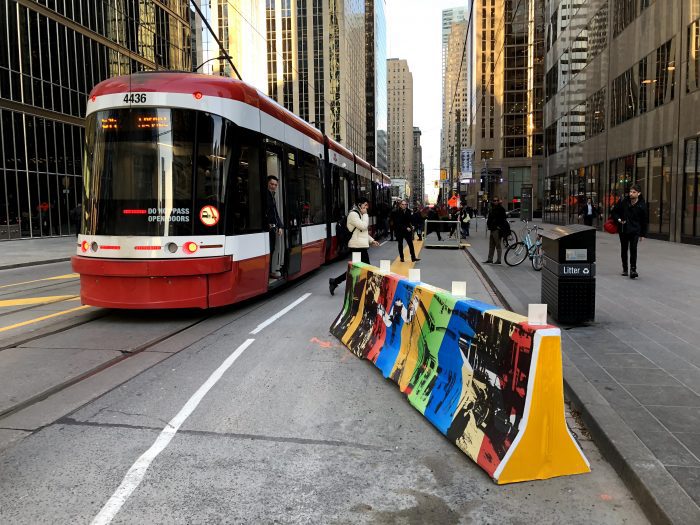After three weeks, Toronto's King Street streetcar-priority pilot is winning people over in rapid fashion. Both anecdotal and empirical evidence suggest travel times have significantly improved for streetcar riders. The Globe and Mail recently called it a "transit miracle" and urged expansion to other city streets.
The 1.6-mile project deflects most private car traffic away from King Street, freeing streetcars from congestion and shaving as much as 10 minutes off some transit trips. Ridership on the King Street Streetcar stood at 65,000 daily trips before the improvements, and the Toronto Transit Commission believes that number is already on the rise.
Toronto did it all for about $1.5 million, using temporary materials like planters and concrete dividers. Christoper Yuen at Human Transit has a great post explaining some of the finer points of the redesign.
Because of garage entrances fronting the four lane street, it couldn't be entirely closed to cars. But anyone who drives on King Street must turn right at the earliest opportunity (left turns are banned). This opens up new possibilities for transit design, Yuen explains:
At the approach to intersections, vehicles waiting to turn right form a queue in the right lane, out of the way of transit. At some intersections, cars receive an advance turn signal ahead of pedestrians to ensure the tail of the turning queue does not impede the streetcars.
Without through-traffic, having two lanes at the start of each block is no longer necessary, allowing for an important feature for efficient transit operations -- far-side stops. Streetcar tracks in Toronto, and in many legacy systems, operate in the middle of the road. To board and alight, passengers must step into the roadway, protected only by a rule prohibiting motorists from passing open streetcar doors. As a result, stops have always been located on the near-side to reduce the risk of drivers making a right turn onto a transit corridor and immediately conflicting with passengers getting on or off a streetcar. Under the new design, streetcars stop on the far side of most intersections, beside barriers that effectively extends the curb to the second lane at the start of each intersection.
In addition to the obvious safety benefits of the new design, the far-side stops also allow transit vehicles to travel faster. Traffic signals along Toronto’s King Street already feature transit signal priority- they detect an approaching transit vehicle to hold a green light, or shorten a red light. With near-side stops, the unpredictable dwell times at stops would sometimes cause the traffic-signal to time-out, leaving the transit vehicle with a red light just as it closes its doors and is ready to get moving. Far side stops allow signals to be held for a streetcar to get through an intersection before stopping for passengers.
The new design also re-allocates curb space as loading zones, taxi stands and for new seating and patio space mid-block- all valuable features for a dense, mixed-use central business district which would not have been possible when all four lanes have been dedicated to the throughput of cars.
More recommended reading today: After a truck driver killed a young woman biking last week, the Bike Coalition of Greater Philadelphia makes the case for protected intersections on Spruce and Pine streets. And the State Smart Transportation Initiative reports that injuries and fatalities have increased dramatically on Ohio highways where the speed limit was increased from 65 to 70 mph.





